Sounds Of 11 OWLS In Texas (Guide With Photos & Calls)
Did you recently hear an owl sound in Texas, and want to know what species it was?
Identifying owl calls in the Lone Star State is not as easy as it might seem, since there are many owls that regularly occur in Texas.
To help you identify the owl you heard, we’ll cover the most common owl sounds of Texas in this article.

What sounds do Texas owls make?
Below we’ve uploaded the sounds of the 11 types of owls found in Texas:
- Great Horned Owl
- Barn Owl
- Long-eared Owl
- Burrowing Owl
- Short-eared Owl
- Eastern Screech-Owl
- Western Screech-Owl
- Barred Owl
- Northern Saw-whet Owl
- Elf Owl
- Flammulated Owl
By learning to recognize their call, you can identify these owls even if it’s hard to see them in the dark of night. This is extremely helpful if you want to identify Texas owls.
And while most of these owls are regular birds in Texas, the last three species on the list are vagrants that only rarely occur in the state.
Now let’s dive in and listen to the calls and sounds of these owls:
Great Horned Owl
Scientific name: Bubo virginianus

Great Horned Owl sounds:
(Recording source: Christopher McPherson, XC691461, www.xeno-canto.org/691461)
The sound recording above is of the territorial song of a Great Horned Owl, which can be heard from both males and females.
With a wingspan up to 4 feet, the Great Horned Owl is the largest owl species breeding in Texas.
This large Texas bird has two ear tufts (also called horns) and big yellow eyes. In Texas, this owl starts its nesting very early in the year, laying its eggs in January or February.
This owl is almost entirely nocturnal, and can hunt in complete darkness by relying on its keen sense of hearing.
The Great Horned Owl doesn’t build its own nest, but instead occupies the nests of other large birds, such as herons or raptors.
It is found year-round throughout Texas, and can be found in a wide variety of habitats in Texas, from woodlands to urban areas.
This owl is a fierce hunter, catching birds up to the size of ducks, and mammals up to the size of squirrels, rabbits, and even young foxes.
Barn Owl
Scientific name: Tyto alba
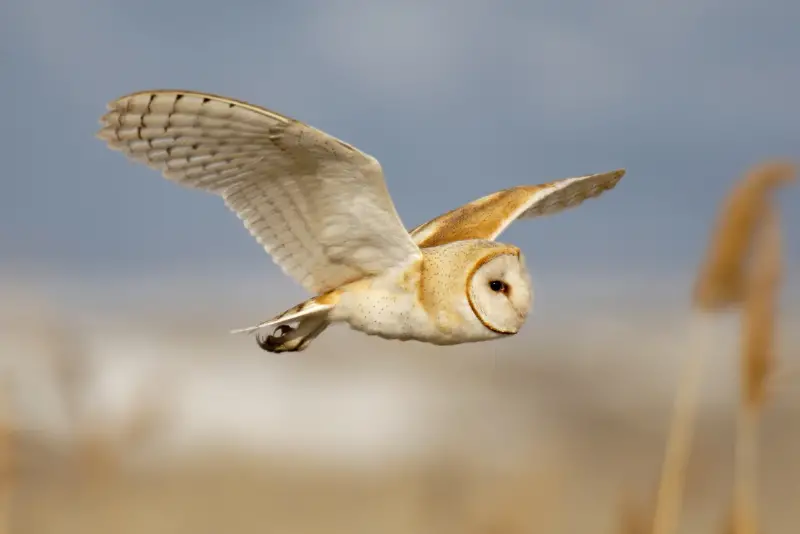
Barn Owl sounds:
(Recording source: Jayrson De Oliveira, XC619814, www.xeno-canto.org/619814)
The sound recording above is of the territorial song of an American Barn Owl. It is a screeching sound that is hard to miss.
Somewhat softer and less intense-looking than the Great Horned Owl, Barn Owls are characterized by their white coat of feathers, and their “friendlier” appearance.
Armed with exceptional night vision, Barn Owls are strictly nocturnal raptors and therefore hard to spot. However, they can be readily identified by their characteristic screeching calls.
And if you do spot one flying overhead by the light of the moon, you may be able to see the bright glow of these white Texas birds.
These owls are present in Texas all year round, and favor open areas and farmland as their hunting grounds.
Long-eared Owl
Scientific name: Asio otus
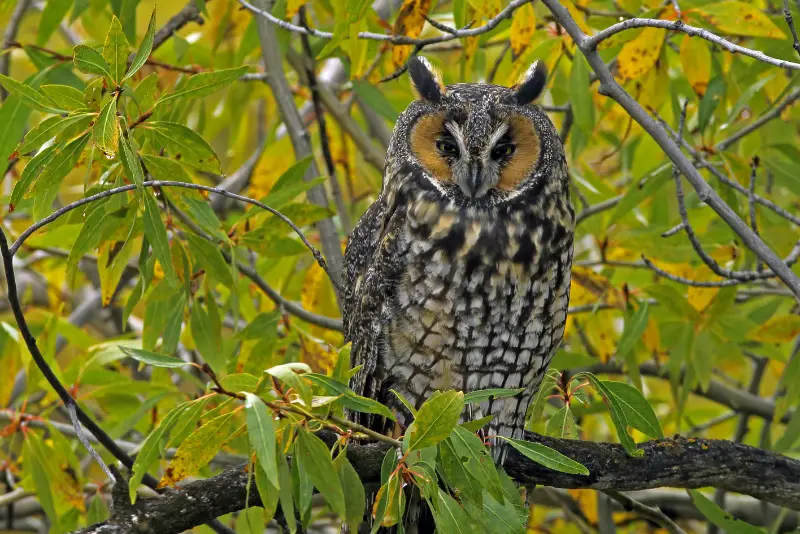
Long-eared Owl call:
(Recording source: Baltasar Pinheiro, XC737794, www.xeno-canto.org/737794)
The sound recording above is of the territorial song of a Long-eared Owl.
These well-camouflaged, elusive owls are smaller than the aforementioned species, and can be seen in Texas during the winter months.
They use their favored habitat of dense wooded areas to prey on the small rodents and animals that call the nearby grasslands their home.
Similar to other owl species, Long-eared Owls can fly completely silently due to fringes on their flight feathers.
Together with their keen sense of hearing, this enables these owls to catch prey by surprising it in the dark of the night.
But despite their best efforts to remain hidden, these owls can be identified by their long, low hoots.
Another great characteristic for identifying these owls is by their elongated tufts of feathers on the ears, and their droppings found underneath conifer trees close to grassy areas.
Burrowing Owl
Scientific name: Athene cunicularia
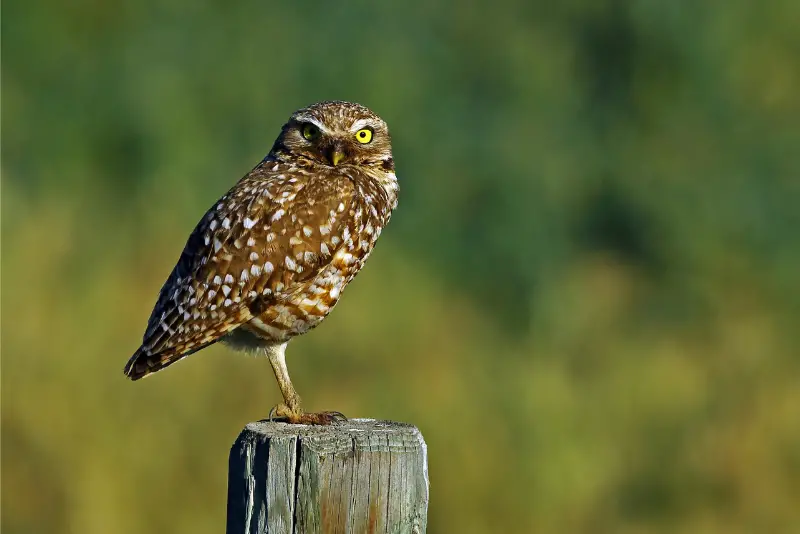
Burrowing Owl sound:
(Recording source: David Ricardo Rodriquez-Villamil, XC524489, www.xeno-canto.org/524489)
The sound recording above is of the territorial song of a Burrowing Owl.
The Burrowing Owl is a scarce resident of open areas in Texas. It digs its own burrows, but also often takes over burrows from prairie dogs or ground squirrels.
This owl is active both day and night, and hunts insects and small rodents in open areas.
Due to their small size, these owls can be hard to spot in the expanse of open prairies.
They are most often observed perching on a small mound, from where they can scan their surroundings in search of food.
Short-eared Owl
Scientific name: Asio flammeus

Short-eared Owl call:
(Recording source: Lars Edenius, XC718743, www.xeno-canto.org/718743)
The sound recording above is of the territorial song of a Short-eared Owl.
The Short-eared Owl is a highly migratory owl species, and while it doesn’t breed in Texas, it is regularly observed in the state outside of the breeding season.
Short-eared Owls are more often observed hunting in daylight than other owls species.
Together with their hunting tactic of flying low over the ground in open areas, this makes these owls relatively easy to spot.
You can encounter these owls in Texas in any kind of open landscapes, including farmland, airports, and fallow land.
Eastern Screech-Owl
Scientific name: Megascops kennicottii
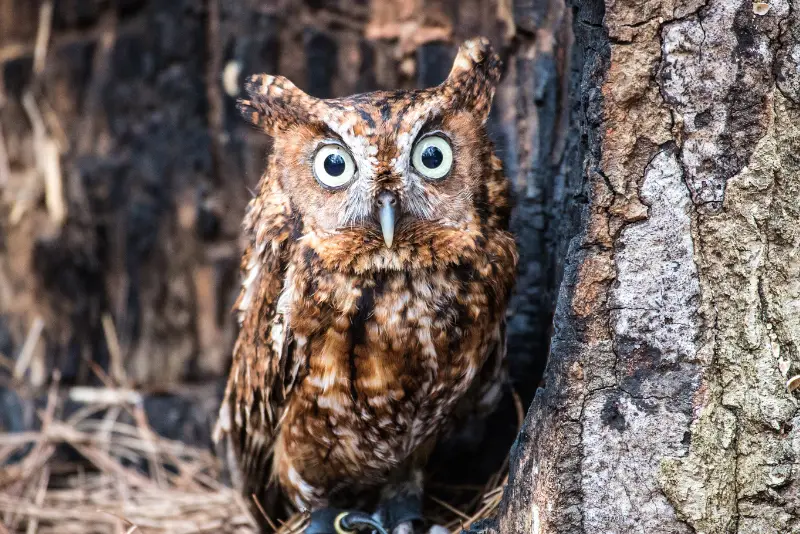
Eastern Screech Owl call:
(Recording source: Wisconagus, XC690687, www.xeno-canto.org/690687)
The sound recording above is of the territorial song of an Eastern Screech-Owl.
Originally birds of open woodlands, Eastern Screech-Owls have adapted very well to urban habitats, and are regularly found in parks, large gardens, and golf courses.
They breed in tree cavities, and are best identified by their characteristic series of accelerating hoots.
These owls are found in central and east Texas and can be seen here all year round.
They have a very varied diet, which includes any type of small animal ranging from worms to insects and rodents.
Eastern Screech-Owls readily accept artificial nesting cavities, which means you can attract them to your backyard by setting up nest boxes.
Western Screech-Owl
Scientific name: Megascops kennicottii
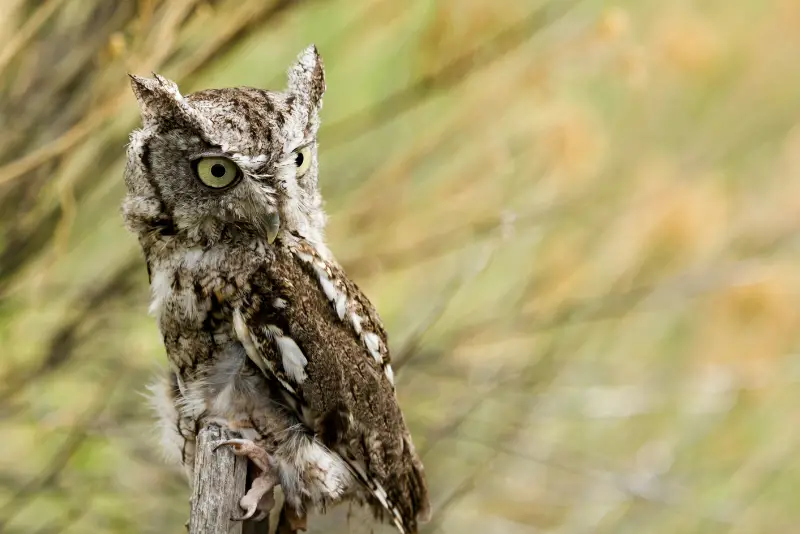
Western Screech Owl sound:
(Recording source: Lance A. M. Benner, XC540561, www.xeno-canto.org/540561)
The sound recording above is of the territorial song of an Eastern Screech-Owl.
Originally birds of open woodlands, Western Screech-Owls have adapted very well to urban habitats, and are regularly found in parks, large gardens, and golf courses.
They breed in tree cavities, and are best identified by their characteristic series of accelerating hoots.
These owls are common birds in west Texas and can be seen there all year round.
They have a very varied diet, which includes any type of small animal ranging from worms to insects and rodents.
Western Screech-Owls readily accept artificial nesting cavities, which means you can attract them to your backyard by setting up nest boxes.
Barred Owl
Scientific name: Strix varia
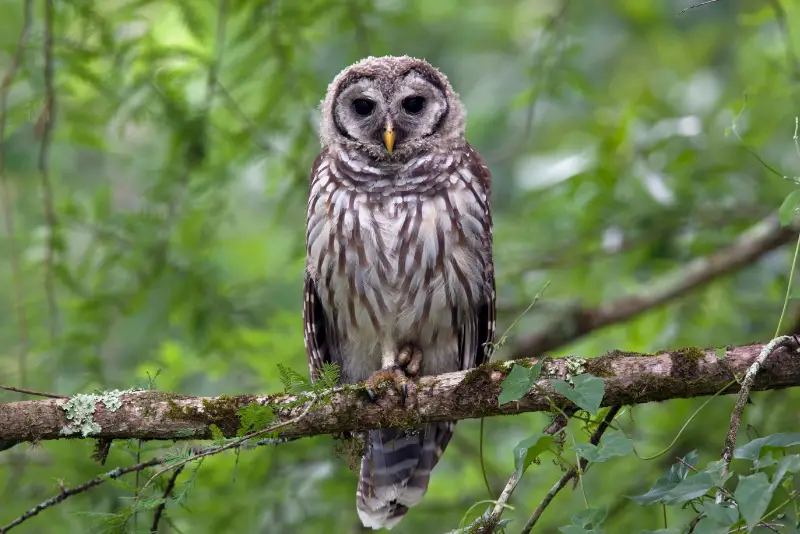
Barred Owl sound:
(Recording source: Jim Berry, XC713081, www.xeno-canto.org/713081)
The sound recording above is of the territorial song of a Barred Owl.
The Barred Owl was originally a bird of eastern North America, but it steadily expanded its range westwards over the past century.
These owls are found in east Texas wherever there are suitable habitats, and are year-round residents that defend their territory in all seasons.
Similar to other owls, the Barred Owl is easiest to find by listening for its characteristic hooting call.
Their preferred habitat is mature forest and forests bordering swamps. They readily accept nest boxes that are set up in old trees.
Northern Saw-whet Owl
Scientific name: Aegolius acadicus

Northern Saw-whet Owl call:
(Recording source: Lance A. M. Benner, XC546885, www.xeno-canto.org/546885)
The sound recording above is of the territorial song of a Northern Saw-whet Owl.
This is another small owl species that’s hardly larger than a pint. These owls are hard to see, but they are easy to detect if you listen for their characteristic too-too-too call at night.
Northern Saw-whet Owls are very rare in Texas, but sometimes show up in the northern parts of the state during winter.
In some years these birds erupt southwards during winter, and can be seen far south of their normal range.
They nest in tree cavities, but also readily accept man made nest boxes. So if you have a large garden with mature trees, it’s worth putting up a nest box well before the nesting season.
Elf Owl
Scientific name: Micrathene whitneyi

Elf Owl call:
(Recording source: Ron Overholtz, XC555495, www.xeno-canto.org/555495)
The sound recording above is of the territorial song of an Elf Owl.
With a total body length of less than 6 inches, the Elf Owl holds the title of being the world’s smallest raptor, which also makes it the smallest owl in Texas.
These strictly nocturnal Texas birds inhabit arid areas, such as deserts, thorn forest, and riparian forests in southwest and west Texas.
They are most common in the Trans-Pecos and Big Bend areas of the Chihuahuan desert, where they nest in abandoned woodpecker cavities.
They predominantly feed on insects, such as grasshoppers and crickets, but also regularly take small vertebrates.
Flammulated Owl
Scientific name: Psiloscops flammeolus
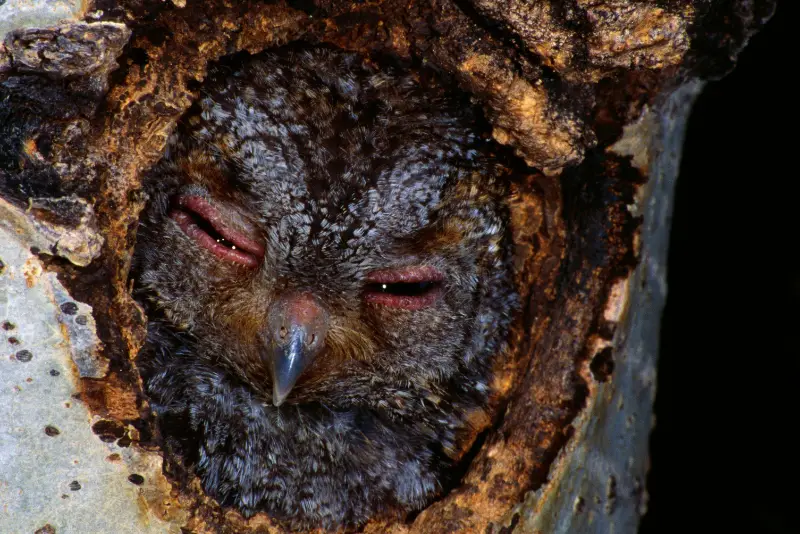
Flammulated Owl call:
(Recording source: Lance A. M. Benner, XC553927, www.xeno-canto.org/553927)
The sound recording above is of the territorial song of a Flammulated Owl.
The Flammulated Owl is currently not a breeding bird in Texas, but is regularly observed during migration.
These small owls are summer visitors in several western states, and pass through west Texas on their way south to their wintering grounds in south Mexico.
In addition to its small size, it also has the habit of foraging for insects in the crowns of tall conifer trees, which makes it hard to observe.
The best way to identify one of these owls is by their low hooting call. They feed almost exclusively on insects.
Conclusion
And there we have the most common owl sounds that can be heard in Texas!
I think you’ll find that, with a little practice, identifying owls by their sounds is much easier than identifying them by sight.
Of course this doesn’t apply when owls are silent, which can be the case with winter visitors such as Snowy Owls or Northern Saw-whet Owls.
If you enjoyed this article, check out our guide to the Texas birds of prey.
